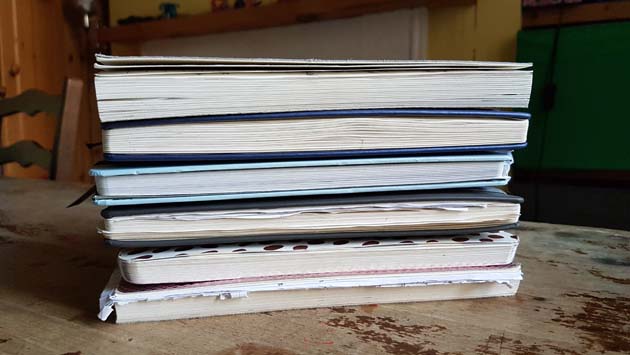
Look at this! I don’t talk about writing for months and then I talk about it for two weeks on the trot! You’ll be relieved to hear, this one is more light-hearted. In my last blog post I mentioned how I wrote the first draft of The Spellbinding Secret of Avery Buckle in notebooks on train journeys. I used to work as an illustrator, so the idea of a sketchbook, carried continuously with me, always ready to record anything that caught my eye, is something that is seared into my DNA. To my current self’s amazement, the first draft of Avery Buckle poured out onto the page in long-hand form like one elongated narrative sketch. I didn’t know any other way to do it. I have only once managed to do that again. Back then I typed up Avery Buckle onto my ancient MAC, and as I typed I edited. Then, once typed up, I edited it again. This isn’t the way I work now at all.
The great thing about sketchbooks is how portable they are, but technology is becoming more portable by the moment. My partner bought me a tiny laptop last year (a glorified word processor really) and I haven’t looked back. First drafts go straight onto the laptop, and my notebooks have become the place where I generate my ideas, throwing around plot plans, sticking in newspaper articles containing little nuggets that have captured my imagination, notes, quotes, and links to topics I want to investigate. These days my notebooks feel more like comfy nests, where I want to snuggle down, and dream until the treasures they contain organise themselves into a story-shaped pattern in my mind.
‘Dreaming’ a book is a really important part of my process. I’ve tried sitting down in front of a blank page with a plot aim for a scene, and the writing has always been laboured. And that may well be an understatement. That kind of writing feels like pulling knotted rope down through my nasal passages. I write best when I have had time to imagine a scene, like a Pinterest mood board in my mind – the colour, the smells, the sounds, and to feel the emotions. In my imagination I push the scene to its most sickly sweet or cruelly dark extremes, and somewhere, there in my imaginings, I find the right note. Then, when I sit down to write, I’m brimming with excitement, bursting with all the feelings the scene has given me, and which I want my reader to feel too.
Unfortunately this kind of writing needs a lot of editing. Writers who have it all planned out avoid significant pain at the editing stage. I tend to run to ten or fifteen drafts. I don’t actually mind editing at all but I do need help with it. I have two writing groups which I am part of. I have a couple of trusted beta readers. I am also incredibly lucky to have a very wonderful agent who is just fabulous. But my notebooks are still very much where my stories begin. And I’m sure that’s more down to the notebook itself than many might like to admit. There is absolutely a kind of magic in unused stationery, those delicious blank pages full of possibility. As Cassandra the witch puts it in The Spellbinding Secret of Avery Buckle,
“Pens. Paper. These things are full of magic; down the spine, inside the nib – full to the brim with some of the strongest magic around.”






